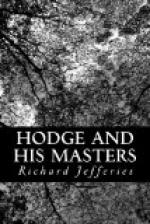The busy summer, with its haymaking, reaping, and continuous succession of harvest work, passes too swiftly for reflection both for masters and men. But in the calm of autumn there is time again to look round. Then white columns of smoke rise up slowly into the tranquil atmosphere, till they overtop the tallest elms, and the odour of the burning couch is carried across the meadows from the lately-ploughed stubble, where the weeds have been collected in heaps and fired. The stubble itself, short and in regular lines, affords less and less cover every year. As the seed is now drilled in, and the plants grow in mathematically straight lines, of course when the crop is reaped, if you stand at one side of the field you can see right across between the short stubbs, so that a mouse could hardly find shelter. Then quickly come the noisy steam ploughing engines, after them the couch collectors, and finally the heaps are burnt, and the strong scent of smoke hangs over the ground. Against these interruptions of their haunts and quiet ways what are the partridges to do? Even at night the place is scarcely their own, for every now and then as the breeze comes along, the smouldering fires are fanned into bright flame, enough to alarm the boldest bird.
In another broad arable field, where the teams have been dragging the plough, but have only just opened a few furrows and gone home, a flock of sheep are feeding, or rather picking up a little, having been, turned in, that nothing might be lost. There is a sense of quietness—of repose; the trees of the copse close by are still, and the dying leaf as it drops falls straight to the ground. A faint haze clings to the distant woods at the foot of the hills; it is afternoon, the best part of an autumn day, and sufficiently warm to make the stile a pleasant resting-place. A dark cloud, whose edges rise curve upon curve, hangs in the sky, fringed with bright white light, for the sun is behind it, and long, narrow streamers of light radiate from the upper part like the pointed rays of an antique crown. Across an interval of blue to the eastward a second massive cloud, white and shining as if beaten out of solid silver, fronts the sun, and reflects the beams passing horizontally through the upper ether downwards on the earth like a mirror.
The sparrows in the stubble rise in a flock and settle down again. Yonder a solitary lark is singing. Then the sun emerges, and the yellow autumn beams flood the pale stubble and the dark red earth of the furrow. On the bushes in the hedge hang the vines of the bryony, bearing thick masses of red berries. The hawthorn leaves in places have turned pale, and are touched, too, towards the stalk with a deep brown hue. The contrast of the two tints causes an accidental colour resembling that of bronze, which catches the eye at the first glance, but disappears on looking closer. Spots of yellow on the elms seem the more brilliant from the background of dull




